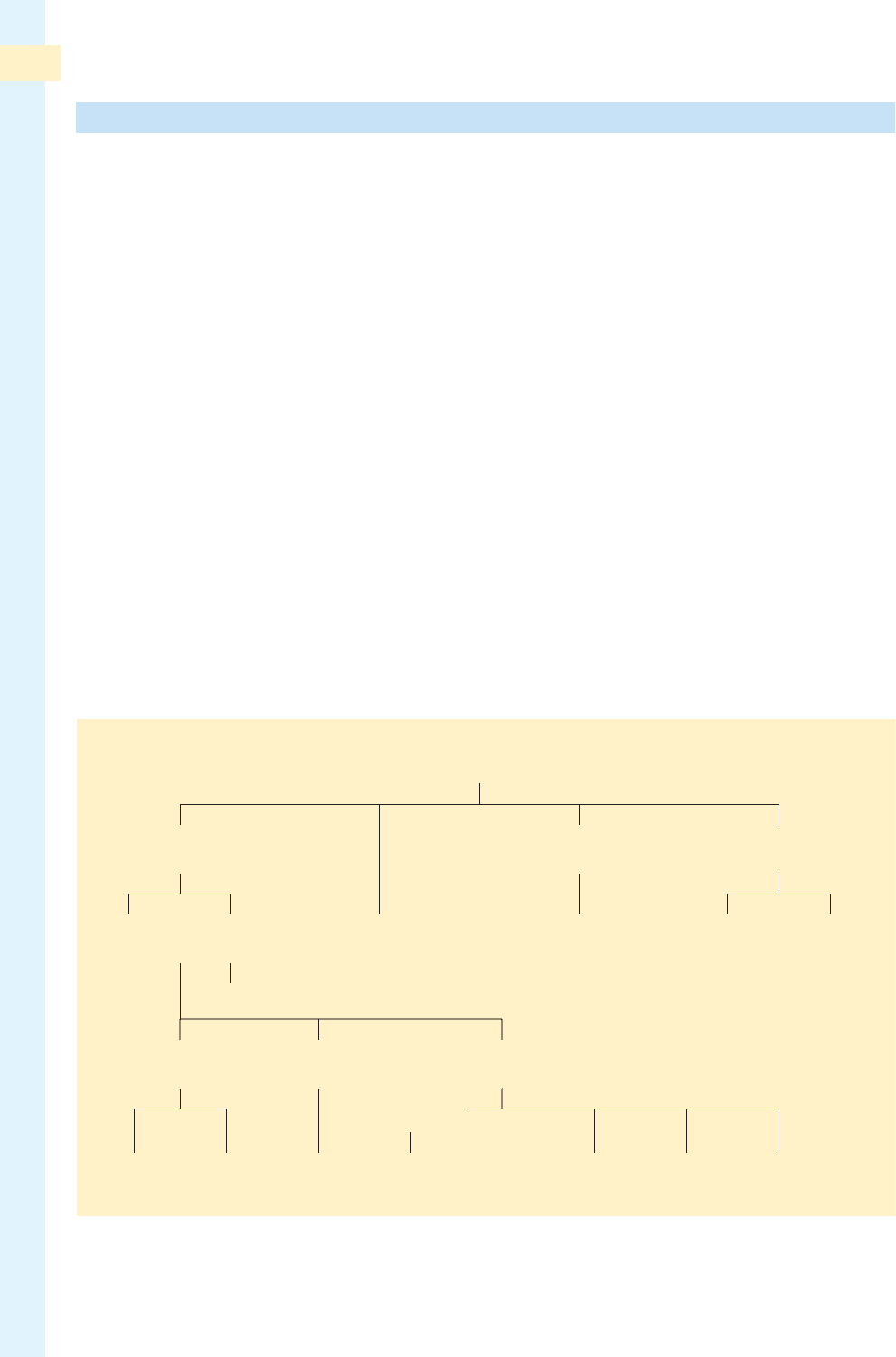Mullins L.J. Management and organisational behaviour, Seventh edition
Подождите немного. Документ загружается.


CHAPTER 23 MANAGEMENT DEVELOPMENT AND ORGANISATIONAL EFFECTIVENESS
OBJECTIVES
Completing this exercise should help you to enhance the following skills:
Analyse key aspects of effective structure, managerial staffing and organisational performance.
Draw attention to priorities for review of the organisation.
Evaluate practical management situations, either now or in the future.
EXERCISE
You are required to imagine you are the managing director or chief executive of your organi-
sation, and complete the following checklist.
aStructure
Does your organisation have: YesNoMaybe
1 an outdated structure – for example, geared to forgotten
■■ ■■ ■■
objectives, old markets, retired top managers;
2a structure that does not allow the organisation to respond to
■■ ■■ ■■
business growth, technical change or to the competition;
3 changed organisational objectives, but structure and staffing
■■ ■■ ■■
basically unchanged;
4 flexibility, adaptability and delegation impeded by
■■ ■■ ■■
bureaucracy or detailed built-in procedures;
5a structure that does not encourage people to readily identify
■■ ■■ ■■
how their role/position relates to the overall objectives and
structure of the organisation?
bManagerial staffing
Does your organisation have:
6 unclear top management succession; or does it offer only a
■■ ■■ ■■
‘Hobson’s Choice’ for several senior positions;
7a general and unduly heavy loss of managers, especially
■■ ■■ ■■
the younger or better ones;
8 quite numerous examples of badly under-employed managers
■■ ■■ ■■
in ‘non-jobs’;
9 development of the organisation clearly held back by a
■■ ■■ ■■
lack of good people;
10 fairly widespread managerial job dissatisfaction and frustration;
■■ ■■ ■■
11 managerial vacancies frequently difficult to fill, from either ■■ ■■ ■■
within or outside the organisation?
PERSONAL AWARENESS AND SKILLS EXERCISE
995

996
PART 8 IMPROVING ORGANISATIONAL PERFORMANCE
cPerformance
Does your organisation have: YesNoMaybe
12 poor organisational performance, due to ineffective
■■ ■■ ■■
management controls;
13 poor performance because of a generally low level of
■■ ■■ ■■
managerial competence for present-day tasks;
14 poor performance which arises from blurred or badly drawn
■■ ■■ ■■
managerial responsibilities;
15 widespread overburdening of managers, which undermines
■■ ■■ ■■
performance;
16 extensive waste of managerial time – for example, in board
■■ ■■ ■■
meetings, committees, working groups;
17 widespread delays in obtaining either decisions, or the
■■ ■■ ■■
information needed to make decisions;
18 frequent failure to seize opportunities, or to react speedily
■■ ■■ ■■
to new challenges?
Use the completed checklist and your own analysis to highlight the priorities for reviewing
your organisation. Compare and discuss your responses with colleagues.
What overall conclusions do you draw about your organisation?
DISCUSSION
■ If you had to make a forced choice and in rank order, what three variables would you say
ultimately determine the effectiveness of an organisation more than any others?
■ What have you learnt about effective organisational performance and your study of man-
agement and organisational behaviour?
Personal awareness and skills exercise continued
Visit our website www.booksites.net/mullins for further questions, annotated weblinks,
case material and Internet research material.

CHAPTER 23 MANAGEMENT DEVELOPMENT AND ORGANISATIONAL EFFECTIVENESS
CASE STUDY 23.1
Chips with everything: managing cultural change at Eurasia
Electronics
Eurasia Electronics is a large high technology com-
pany in the consumer electronics industry. It has
ten plants in six countries and employs about 7000
people. Its headquarters are located in Singapore
with production facilities in Europe and South East
Asia. Eurasia’s initial success was due to its excellent
record of innovation and in developing close links
with its customer base through its association with a
major European retail outlet and clever marketing
strategy. It growth strategy has been to concentrate
particularly on computer games, personalised music
systems and to develop products for the emerging
digital market.
However, over the past two years each of Eurasia’s
plants has suffered from a marked downturn in
profits and a decrease in their market share. The
main reason for this has been the turbulent business
environment in which rapid product obsolescence
and increasing competition affected the company’s
profit and market share.
Eurasia recognised this turbulence in the market
and put forward a strategy aimed at maintaining
tighter controls over production costs. Although
production costs were substantially reduced, the
result was that managers focused entirely on cost-
cutting measures with little attention being paid to
innovation and product development.
At a recent seminar you all attended, the Chief
Executive (CE) called you (the Company Secretary)
and a Singapore director over to discuss the problem
of the group’s poor performance. The CE is convinced
that the poor results were as a direct result of the
strategy to control costs and in doing so this sent the
wrong messages to each of the Regional Directors.
The CE is aware that if the situation in each plant is
not rectified quickly, the Board is likely to take steps
to restructure the business or to sell off parts of it
which will result in job losses on a large scale.
YOUR TASKS
a The CE has read about the merits of introducing
‘Organisational Learning’ in a multinational con-
text. He asks you to prepare a brief report on how
this concept could be used in improving the cur-
rent performance across the group.
b The CE feels that the regional management teams
in each plant are isolated from the thinking of the
main Board. The CE is also concerned that the
main Board itself does not know what the opera-
tional teams in each plant think. He asks you what
action might be taken to remedy this lack of cor-
porate communication.
c It is apparent that in order for Eurasia to improve
its market share, many changes need to be made
in order to restore the innovative culture Eurasia
was once so famous for. You have been asked by
the CE to prepare a presentation for him for a
multinational management seminar on ‘Managing
Cultural Change at Eurasia’.
CASE STUDY 23.2
Holding the front page: expansion at Rudmore Press Ltd
Rudmore Press was founded in the early 1970s by
the current managing director, Tony Stone, and his
friend and partner, Roger Preston. The original com-
pany was housed in a large shed in Tony’s garden
and start-up capital to buy the first hand-operated
printing press was provided by his parents. From
this inauspicious beginning, the company expanded
into its own premises in the early 1980s and then
again in the mid-1990s to a purpose-built factory
and warehouse. The company provides a wide range
of printing work to local businesses and operates in
a highly competitive market.
997

PART 8 IMPROVING ORGANISATIONAL PERFORMANCE
In the beginning, lack of working capital caused
much work to be contracted out, but a policy of
continuing investment meant that the company has
now been able to equip its premises with the latest
colour printing presses and computerised typeset-
ting facilities. This has enabled most work now to be
completed in-house, a service which has been
enhanced by joining forces with two small inde-
pendent lithographic companies who run the
in-house plate making services from Rudmore’s
premises. Modern production facilities are under-
pinned by a comprehensive warehouse system
housing guillotines and folding and cutting
machines, together with a computerised dispatch
system which produces and co-ordinates all cus-
tomer documentation.
The original two-man team was joined in the late
1980s by Gerry Farr to oversee production; shop-
floor and supervisory staff were taken on as business
levels demanded. Rapid growth during the middle
and late 1900s meant that the company seriously
had to review its organisation structure. Gerry Farr
was promoted to works director; Roger Preston
moved from works manager to marketing director to
reflect the need which the company had identified
to seek out new markets; and Tony’s wife, Anthea,
was brought in to the company on a part-time basis
to oversee administration and personnel.
Additionally, a quality controller, Joyce Baker, was
appointed to lead the initiative to obtain the
International Standards Organisation Approved
Quality Standard Certificate. (See Figure 23.12.)
Tony is a dynamic managing director who
realises that the organisation is still very much in
an embryonic state of development. A highly intel-
ligent and charismatic figure, well known in the
local community, he believes in allowing people to
manage their own functions and becomes frus-
trated when they appear to be failing to do so.
Passionately believing in his company, he always
seems to know what is going on. He works long
hours, often appearing to tackle several important
tasks at once, and sets himself, and others, tight
deadlines and seemingly impossible objectives. He
has received little formal management training and
recognises this possible shortfall in his develop-
ment, but never seems to find the time to
undertake a course of study. He feels that he has a
moral and financial obligation to Roger, his original
partner who is now a major shareholder.
Case study 23.2 continued
MANAGING DIRECTOR
Tony Stone
WORKS DIRECTOR
Gary Farr
Quality
controller
Joyce Baker
MARKETING DIRECTOR
Roger Preston
ADMINISTRATION DIRECTOR
Anthea Stone
Estimator Sales team
(3)
Gen admin
(2)
Accounts asst
(1)
Production
office (3)
(1) Apprentice
Studio
supervisor
Typesetter
(3)
Artwork
(1)
Print
supervisor
7 Printers 8 Finishers
Asst supervisor
Hand finishing
Bindery
supervisor
Cutting &
folding (4)
Muller
(1)
Warehouse
(2)
Figure 23.12 Rudmore Press Ltd: organisation chart
998

CHAPTER 23 MANAGEMENT DEVELOPMENT AND ORGANISATIONAL EFFECTIVENESS
Conversely, Roger is an introverted individual
who is devoted to his wife and family. He believes
that the company has grown too quickly for his
own personal comfort. He feels most at home when
getting his hands dirty on one of the presses and
doesn’t really want to be the marketing director.
Indeed, he isn’t really sure what the job involves
except that Tony had told him that he is to search
out new markets and improve sales. Tony had also
recently asked him to recruit and manage a small
sales team, a task that Roger had inwardly dreaded.
Gerry Farr is very much a ‘hands on’ manager
who began his career as a printer. He feels happiest
when he is on ‘his’ shopfloor rather than in the
boardroom. Tony has identified a management
course for Gerry to attend but Gerry is resisting it on
the grounds of pressure of work. On this note, Gerry
feels than he works very hard, often putting in more
hours than the other three, and sometimes feels
resentful that, unlike the others, he has no share-
holding in the company.
Tony’s wife, Anthea, has been co-opted into the
company to bring some order to the administrative
function. Calm and capable, she is the perfect foil
for her husband’s management style. Freely admit-
ting that, having trained as an infant teacher, she
has little related experience, Anthea is nevertheless
ready and willing to learn whatever is needed in
order to drive the organisation forward. She does
not see her role as a permanent one and eventually
wants to return to what she considers as her main
role, that of looking after her husband and children.
Communication within the company is informal
and more likely to take the form of conversations
with individuals rather than written memoranda or
email. Likewise there are few, if any, laid-down poli-
cies or procedures other than those in place in the
dispatch department and warehouse. If systems are
needed, they are added on an ad hoc basis. Staff at
all levels of the organisation also seem to be
recruited by this same approach. Tony, who has
recently read an article in a management magazine
on the subject, is proud that the organisation is
adopting what he terms ‘the contingency approach’.
This view is not shared by Roger who, liking order
and discipline, prefers to know exactly what is
expected of him, nor by Gerry who just wants to be
allowed to get on with production unhindered by
what he terms ‘Tony’s meddling’.
As Rudmore entered the 2000s, Tony Stone
realised that major changes were needed if the com-
pany was to continue its planned expansion. He
applied for, and was awarded, a government grant
that enabled him to appoint a team of consultants
to undertake an analysis of the organisation and
report back to him with their recommendations.
Tony’s first comment to the consultants was: ‘the
four of us have been together for a long time now but
I can’t seem to motivate them any more’. When the
consultants interviewed the other key members of
the organisation they repeatedly heard comments
along similar lines: ‘Everything was OK when we
were a very small company and everyone knew what
everyone else was doing. Since we started to expand
we’re no longer a team and Tony has become a bit of
a bully. He either sets us targets, which are impos-
sible, or treats us like idiots. We are no longer a team
but a group of people working in a dictatorship.’
One of Anthea Stone’s main concerns was to the
effect that there is a growing problem of authority
and accountability that has come with expansion of
the company. In the consultants’ discussions with
Roger, he made the comment that: ‘I think one of the
main problems is that the staff have the wrong atti-
tude and approach for what I am trying to achieve.’
(This case study has been prepared jointly with, and from original
material supplied by, my colleague Karen Meudell.)
YOUR TASKS
As a member of the consultancy team you are
required to prepare a report indicating clearly:
a the factors to be considered in your analysis of
the organisation;
b which of these factors should be given the highest
priority, together with your supporting reasons;
c how your ideas and recommendations might best
be implemented; and
d the relevant theoretical or other models you would
bear in mind.
999

1000
PART 8 IMPROVING ORGANISATIONAL PERFORMANCE
NOTES AND REFERENCES
1. ‘Untapped Potential: The barriers to optimum corpor-
ate productivity’, Proudfoot Consulting, October
2002. For a summary, see: ‘News Update’, Manager,
The British Journal of Administrative Management,
no. 34, New Year 2003, p. 6.
2. Stern, S. ‘Enhancing Your Talent’, Management Today,
October 2002, pp. 2–3.
3. Stewart, R. The Reality of Management, Third edition,
Butterworth Heinemann (1999), p. 74.
4. Lilley, D. ‘Managerial Development: Where do the
Professions sit?’, The British Journal of Administrative
Management, 29, January/February 2002, pp. 22–3.
5. Heller, R. In Search of European Excellence, HarperCollins
Business (1997), p. xvi.
6. Managing Tomorrow, Panel of Inquiry Report, Local
Government Management Board, 1993.
7. ‘Management Development from Cradle to Grave’,
The British Journal of Administrative Management, 29,
January/February 2002, pp. 8–13.
8. See, for example: Gretton, I. ‘Taking the Lead in
Leadership’, Professional Manager, January 1995,
pp. 20–2.
9. Stern, S. ‘Someone To Talk To’, Management Today,
July 2002, pp. 56–9.
10.
Clarke, K. ‘Survival Skills for a New Breed’, Management
Today, December 1993, p. 5.
11. Patching, K. Management and Organisation Development,
Macmillan Business (1999).
12. Weston, J. ‘Room to Learn: training in the board-
room’, Chartered Secretary, March 2002, p. 19.
13. Macken, G. ‘Taking an Holistic Approach’, Professional
Manager, May 1997, p. 7.
14. Mullins, L. J. and Aldrich, P. ‘An Integrated Model of
Management and Managerial Development’, Journal
of Management Development, vol. 7, no. 3, 1988,
pp. 29–39.
15.
Payne, R. and Pugh, D. S. ‘Organizations as Psychological
Environments’, in Warr, P. B. (ed.) Psychology at Work,
Penguin (1971).
16. Stewart, R. Choices for the Manager, McGraw-Hill
(1982).
17. Blake, R. R. and Mouton, J. S. The Managerial Grid III,
Gulf Publishing Company (1985).
18. Mintzberg, H. The Nature of Managerial Work, Harper
and Row (1973).
19. Miner, J. B. Management Theory, Macmillan (1971).
20. McGregor, D. The Human Side of Enterprise, Penguin
(1987).
21. Blake, R. R. and Mouton, J. S. The Managerial Grid III,
Gulf Publishing Company (1985).
22. Likert, R. and Likert, J. G. New Ways of Managing
Conflict, McGraw-Hill (1976).
23. Drucker, P. F. The Effective Executive, Heinemann
Professional (1988); Reddin, W. J. Managerial
Effectiveness, McGraw-Hill (1970).
24. Mintzberg, H. The Nature of Managerial Work, Harper
and Row (1973).
25. Ribeaux, P. and Poppleton, S. E. Psychology and Work:
An Introduction, Revised edition, Macmillan (1983).
26. Stewart, R. The Reality of Management, Third edition,
Butterworth Heinemann (1999).
27. See, for example: Nixon, B. and Pitts, G. ‘W. H. Smith
Develops a New Approach to Developing Senior
Managers’, Industrial and Commercial Training, vol. 23,
no. 6, 1991, pp. 3–10.
28. Mathison, C. S. ‘Establishing The Management
Development Function’, The British Journal of
Administrative Management, April/May 1992, pp. 8–11.
29. See, for example: Billsberry, J. ‘There’s Nothing So
Practical as a Good Theory: How Can Theory Help
Managers Become More Effective?’, The Effective
Manager: Perspectives and Illustrations, Sage Publications
(1996), pp. 1–27.
30. See, for example: Lucas, E. ‘Workers’ play time’,
Professional Manager, vol. 12, no. 5, September 2003,
pp. 29–31. See also: De Vita, E. ‘Training à la Mode’,
Management Today, January 2004, pp. 50–1.
31. Revans, R. ABC of Action Learning, Chartwell-Bratt
(1983).
32. Inglis, S. and Lewis, B. ‘Action Learning – The Key to
the Competitive Edge’, Professional Manager, May
1994, pp. 16–17.
33. Crainer, S. Key Management Ideas: Thinkers that
Changed the Management World, Third edition,
Financial Times Prentice Hall (1998), p. 259
34. Hazard, H. ‘An Action Learning Teacher Reflects on
Case Teaching’, ECCHO: The Newsletter of the European
Case Clearing House, Issue No. 22, Autumn/Fall 1999,
pp. 6–7
35. Lound, E. ‘Transforming Management Development’,
The British Journal of Administrative Management,
March/April 2002, pp. 34–5.
36. Altman, W. ‘Dead Men’s Shoes’, Professional Manager,
vol. 12, no. 4, July 2003, pp. 16–17.
37. Duncan, D. ‘Making Square Pegs Fit’, The British
Journal of Administrative Management, November/
December 1997, p. 8.
38. Baldwin, J. ‘CPD Pays Dividends’, Supplement to
Chartered Secretary, June 2002.
39. See, for example: Pilbeam, S. and Corbridge, M. People
Resourcing: HRM in Practice, Second edition, Financial
Times Prentice Hall (2002).
40. Farren, C. ‘Mastery: The Critical Advantage’, in
Chowdhury, S. ‘Management 21C, Financial Times
Prentice Hall (2000), p. 98.
41. The Making of British Managers (the Constable and
McCormick Report), British Institute of Management
(1987).
42. The Making of Managers: A Report on Management
Education, Training and Development in the United
States, West Germany, France, Japan and the UK (the
Handy Report), National Economic Development
Office (1987).
43. A Portrait of Management Development, The Institute of
Management, June 1997.

CHAPTER 23 MANAGEMENT DEVELOPMENT AND ORGANISATIONAL EFFECTIVENESS
1001
44. Mabey, C. ‘Developing Managers In Europe’,
Chartered Management Institute (2004). For a sum-
mary, see: ‘Training policies and practice across
Europe revealed’, Professional Manager, January 2004,
p. 25.
45. Brewis, J. ‘The Making of the Competent Manager:
Competency Development, Personal Effectiveness
and Foucault’, Management Learning, vol. 27, no. 1,
1996, pp. 65–86.
46. Pilbeam, S. and Corbridge, M. People Resourcing: HRM
in Practice, Second edition, Financial Times Prentice
Hall (2002), p. 511. See also: Armitage, K. ‘Are You a
Standard Manager?’, Manager, the British Journal of
Administrative Management, January/February, 2004,
pp. 18–19.
47. ‘The Leadership and Management Model’, Investors In
People UK, 2003.
48. Handy, C. B. Understanding Organizations, Fourth edi-
tion, Penguin (1993).
49. For a fuller discussion see, for example: Baguley, P.
Improving Organizational Performance: A Handbook For
Managers, McGraw-Hill (1994).
50. Mann, S. ‘Doing Things Differently’, Professional
Manager, vol. 12, no. 3, May 2003, pp. 34–5.
51. Dunderdale, P. ‘Analysing Effective Organisations’,
Professional Manager, September 1994, pp. 23–5.
52. ‘Effective Organisations: the people factor’, Advisory
Booklet, ACAS, November 2001.
53. Allen, R. S. and Helms, M. M. ‘Employee Perceptions
of the Relationship between Strategy, Rewards and
Organizational Performance’, Journal of Business
Strategies, vol. 19, no. 2, Fall 2002, pp. 115–39.
54. Peters, T. J. and Waterman, R. H. In Search of Excellence,
Harper and Row (1982).
55. Ibid., p. 9.
56. For a fuller account of the development of the Seven
S framework, see: Crainer, S. Key Management Ideas:
Thinkers that Changed the Management World, Third
edition, Financial Times Prentice Hall (1998),
pp. 118–25.
57. Heller, R. In Search of European Excellence, HarperCollins
Business (1997), p. xiv.
58. Goldsmith, W. and Clutterbuck, D. The Winning
Streak Mark II, Orion Business Books (1998), pp. ix–x.
59. See, for example: Caulkin, S. ‘Chris Argyris’,
Management Today, October 1997, pp. 58–9.
60. Senge, P. M. The Fifth Discipline: The Art of Practice of
the Learning Organization, Doubleday (1990).
61. McKenna, E. Business Psychology & Organisational
Behaviour, Lawrence Erlbaum (1994), p. 211.
62. Pedler, M., Burgoyne, J. and Boydell, T. (eds) Applying
Self-Development in Organizations, Prentice-Hall
(1988), p. 209.
63. Garratt, B. The Fish Rots From The Head, HarperCollins
(1996). See also: Garratt, B. The Learning Organization:
Developing Democracy at Work, HarperCollins Business
(2000).
64. Modena, M. ‘A Matter of Balance’, Professional
Manager, vol. 12, no. 4, July 2003, pp. 34–5.
65. Lane, T., Snow, D. and Labrow, P. ‘Learning to
Succeed with ICT’, The British Journal of Administrative
Management, May/June 2000, pp. 14–15.
66. Deming, W. E. Out of Crisis, Cambridge University
Press (1986) and The New Economies for Industry,
Cambridge University Press (1993).
67. Total Quality: Getting TQM to Work’, Checklist 030,
Institute of Management, November 2001.
68. Cane, S. Kaizen Strategies for Winning Through People,
Pitman Publishing (1996), p. 8.
69. www.kaizen-institute.com, Kaizen Institute Ltd (2000).
70. Pentecost, D. ‘Quality Management: The Human
Factor’, European Participation Monitor, Issue no. 2,
1991, pp. 8–10.
71.
Lammermeyr, H. U. ‘Human Relationships – The Key to
Total Quality Management’, Total Quality Management,
vol. 12, no. 2, 1991, pp. 175–80.
72. Whitfield, J. M., Anthony, W. P. and Kacmar, K. M.
‘Evaluation of Team-Based Management: A Case
Study, Journal of Organizational Change Management,
vol. 8. no. 2, 1995, pp. 17–28.
73. For details of the core concepts of TQM see, for ex-
ample: Oakland, J. S. Total Quality Management,
Second edition, Butterworth Heinemann (1994).
74. See, for example: Snape, E., Wilkinson, A.,
Marchington, M. and Redman, T. ‘Managing Human
Resources for TQM: Possibilities and Pitfalls’, Employee
Relations, vol. 17, no. 3, 1995, pp. 42–51.
75. James, G. Quality of Working Life and Total Quality
Management, ACAS Work Research Unit Occasional
Paper no. 50, November 1991.
76. Thomas, B. The Human Dimension of Quality,
McGraw-Hill (1995), p. 185.
77. See, for example: Pike, J. and Barnes, R. TQM in
Action, Second edition, Chapman & Hall (1996).
78. Heller, R. In Search of European Excellence, HarperCollins
Business (1997), p. 239.
79. Kreitner, R., Kinicki, A. and Buelens, M. Organizational
Behaviour, First European Edition, McGraw-Hill (1999),
p. 14.
80. Drummond, H. Introduction to Organizational
Behaviour, Oxford University Press (2000), p. 112.
81. Allen, R. S. and Kilmann, R. H. ‘Aligning Reward
Practices in Support of Total Quality Management’,
Business Horizons, vol. 44, no. 3, May 2001.
82. Hammer, M. and Champy, J. Re-engineering the
Corporation: A Manifesto For Business Revolution,
Nicholas Brealey (1993), p. 32.
83. Stewart, T. A. ‘Re-engineering: The Hot New
Management Tool’, Fortune, 23 August 1993, pp. 41–8.
84. Hill, F. M. and Collins, L. K. ‘The positioning of BPR
and TQM in Long-term Organizational Change
Strategies’, The TQM Magazine, vol. 10, no. 6, 1998,
p. 445.
85. Moylan, P. ‘Competing on Service Delivery Through
Business Process Re-Engineering’ in Taylor, B. (ed.)
Successful Change Strategies: Chief Executives in Action,
Director Books (1994), pp. 100–12.

1002
PART 8 IMPROVING ORGANISATIONAL PERFORMANCE
86. Thomas, M. ‘What You Need to Know About Business
Process Re-Engineering’, Personnel Management,
January 1994, p. 31.
87. Coulson-Thomas C, ‘Business Process Re-engineering:
Nirvana or Nemesis for Europe?, Business Process Re-
engineering: Myth & Reality, Kogan Page (1996).
88. Reis, D. and Pena, L. ‘Reengineering the Motivation
to Work’, Management Decision, vol. 39, no. 8, 2001,
pp. 666–75.
89. I am grateful to my colleague Martin Brunner for his
contribution to Building Tomorrow’s Company and
The EFQM Excellence Model.
90. RSA, Tomorrow’s Company – The Role of Business in a
Changing World, RSA (1995).
91. News from the Centre, Issue 6, Spring/Summer 2000,
p. 4.
92. Oakland, J. S. Total Organisational Excellence: Achieving
World-Class Performance, Butterworth Heinemann
(1999), p. 99.
93. Goasdoué, J. ‘Is Quality Taken for Granted?’, The
British Journal of Administrative Management, February
2001, p. 10.
94. The ‘X’ Factor, Winning Performance through Business
Excellence, European Centre for Business Excellence
(1999), p. 12.
95. Farrar, M. ‘The Excellent Organisation’, Manager, The
British Journal of Administrative Management,
January/February 2004, pp. 24–5.
96.
Steele, M. Assessing Organisational Effectiveness, Cranfield
School of Management, Working Paper 5/88, 1987.
97. Rummler, G. A. and Brache, A. P. Improving
Performance: How to Manage the White Space on the
Organization Chart, Second edition, Jossey-Bass (1995).
98. Crainer, S. and Dearlove, D. (eds), Financial Times
Handbook of Management, Second edition, Financial
Times Prentice Hall (2001), p. 405.
99. Barnes, P. ‘Benchmarking – a technique of the 90s to
be used with care’, Chartered Secretary, May 1999, pp.
30–1.
100. Modena, M. ‘A Matter of Balance’, Professional
Manager, vol. 12, no. 4, July 2003, pp. 34–5.
101. Bishop, P. ‘Benchmarking – a Misconceived Business
Asset’, The British Journal of Administrative Management,
February 2001, pp. 12–13.
102. See, for example: ‘Managing high performance in the
public sector’, IRS Employment Trends, 690, October
1999, pp. 5–16.
103. Prowle, M. ‘Performance Indicators and Performance
Management in the Public Sector’, Chartered Secretary,
February 2001, pp. 18–19.
104. Ittner, C. and Larcker, D. ‘A Bigger Yardstick for
Company Performance’, in Pickford, J. (ed), Financial
Times Mastering Management 2.0, Financial Times
Prentice Hall (2001), pp. 385–9.
105. Gratton, L. Living Strategy, putting people at the heart of
corporate purpose, Financial Times Prentice Hall (2000),
p. 99.
106. Crainer, S. ‘The Rise of Guru Scepticism’, Management
Today, March 1996, p. 50.
107. Chowdhury, S. Management 21C, Financial Times
Prentice Hall (2000), p. 10.
FT
Use the Financial Times to enhance your understanding of the context and practice of management
and organisational behaviour. Refer to articles 11, 23, 24, 27, 28 and 29 in the BUSINESS PRESS
section at the end of the book for relevant reports on the issues explored in this chapter.

However much of a cliché it may sound, it is still an inescapable fact that people are
the main resource of any organisation. Without its members, an organisation is noth-
ing: an organisation is only as good as the people who work within it. In today’s
increasingly global and competitive environment the effective management of people
is even more important for organisational survival and success. Accordingly, the under-
lying theme of this book has been the need for organisational effectiveness and the
importance of the role of management as an integrating activity. It has been concerned
with interactions among the structure and operation of organisations, the process of
management and the behaviour of people at work.
The nature of organisational behaviour and the practice of management should not
be considered in a vacuum but within an organisational context and environment.
However, no single book could hope to have covered adequately all aspects of such a
wide and multidisciplinary field of inquiry. In order to attain a reasonable level of
depth, therefore, the book has concentrated on selected topics of particular interest to
problems of organisation and the management of people in the work situation, and
which meet the needs of the intended audience.
The work organisation is a constantly changing network of interrelated activities
and the behaviour of people cannot be studied in isolation. It is hoped that the con-
cepts and ideas presented in this book have provided a basis on which to formulate a
critical appraisal of contrasting perspectives on the nature of organisational behaviour
and the practice of management. It is also hoped that the book has provided you with
an enhanced understanding of the nature of the people–organisation relationship, the
broader context in which the process of managing people takes place, and ways in
which organisational performance may be improved through the better use of human
resources and the effective management of people.
I hope that you received some measure of satisfaction, even enjoyment, from the
book. Thank you for looking at it.
Laurie J. Mullins
CONCLUSION
Work was like a stick. It had two ends. When you worked for the knowing
you gave them quality; when you worked for the fool you simply gave
them eye-wash.
Alexander Solzhenitsyn
One Day in the Life of Ivan Denisovich (1962)
Conventional texts on management often define organizations as groups
of people united by a common goal. This kind of definition eliminates
almost all the interesting features of organizations in practice. They are
rarely so rational and so united as the definition suggests.
Gareth Morgan
Creative Organization Theory: A Resourcebook, Sage Publications (1989)
